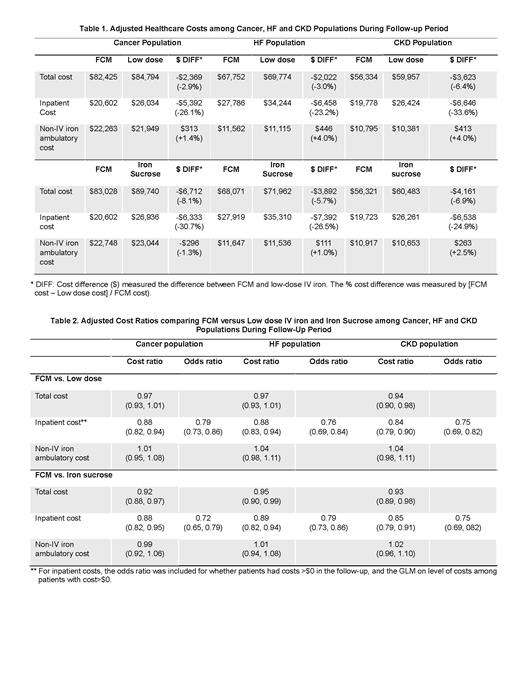INTRODUCTION: An estimated 5 million patients in the United States have iron deficiency anemia (IDA). Although most patients with IDA initiate treatment with oral iron therapy, IV iron replacement therapy is often required in patients with chronic inflammatory diseases such as cancer, heart failure (HF) or chronic kidney disease (CKD). The 2022 AHA/ACC/HFSA recommends IV iron as a treatment option for patients with HF with reduced ejection fraction and iron deficiency with or without anemia.
There is limited real-world data on the economic value of IV iron treatment. This study examined health care costs for patients treated with ferric carboxymaltose (FCM) and patients treated with low-dose IV iron therapy in the populations with cancer, HF or CKD.
METHODS: This study included commercial and Medicare Advantage patients from the Optum Research Database, a large, national United States administrative claims database. Patients were included if they were treated with IV iron therapy from 2017 to 2019; the first treatment date was the index date. Patient were required to have cancer, HF, or CKD in addition to an IDA diagnosis. Continuous enrollment was required for a 6-month baseline and 12-month follow-up period (with patients retained if they had <12 months due to death). Cohorts were classified based on index date treatment: FCM patients received ferric carboxymaltose; low-dose IV iron patients were treated with iron sucrose, iron dextran, or sodium ferric gluconate complex in sucrose. Follow-up all-cause total costs were compared using generalized linear models, and inpatient costs estimated with 2-part models to account for patients with no hospitalizations. Models adjusted for age, gender, geographic region, plan type, index year, comorbidity score, and baseline health care cost. Sensitivity analyses compared FCM with the subgroup treated with iron sucrose.
RESULTS:Cancer population: Of 10,763 cancer patients meeting eligibility criteria, 5,892 patients received FCM, and 4,871 patients received low-dose IV iron. Within the low-dose IV iron cohort, 3,040 patients (62%) received iron sucrose. The meanadjusted all-cause total cost was similar between FCM and low-dose IV iron (cost ratio 0.97; p=0.182) and significantly lower for FCM vs. iron sucrose (cost ratio 0.92; p=0.001). Adjusted all-cause inpatient costs for FCM were lower compared to low-dose IV iron due to lower risk of hospitalization (odds ratio 0.79, p<0.001) and reduced inpatient costs if hospitalized (cost ratio 0.88; p<0.001); results were similar versus iron sucrose (p<0.001).
HF population: Of 8,337 HF patients, 3,364 patients received FCM, and 4,973 patients received low-dose IV iron therapy. Within the low-dose IV iron cohort, 3,471 patients (70%) received iron sucrose. All-cause total cost for FCM was similar to low-dose IV iron (cost ratio 0.97, p=0.198) but significantly lower for iron sucrose (0.95, p=0.024) during follow-up period. All-cause inpatient cost was also lower for FCM compared to lose-dose IV iron (odds ratio 0.76; cost ratio 0.88; p<0.001) and iron sucrose (odds ratio 0.79; cost ratio 0.85; p<0.001).
CKD population: Of 10,617 CKD patients, 4,377 patients received FCM, and 6,240 patients received low-dose IV iron. Within the low-dose IV iron cohort, 4,584 patients (73%) received iron sucrose. During the follow-up period, the mean adjusted all cause total cost was significantly lower for FCM compared to low-dose IV iron (cost ratio 0.94; p=0.006) and iron sucrose (cost ratio 0.93; p=0.004). All-cause inpatient cost was also lower for FCM compared to low-dose IV iron (odds ratio 0.75; cost ratio 0.84; p<0.001) and iron sucrose (odds ratio 0.75; cost ratio 0.89; p<0.001).
CONCLUSIONS: Despitethe higher drug acquisition cost ofFCM relative to low-dose IV iron, the drug price differential was offset by lower inpatient cost incurred in the FCM group. This resulted in similar all-cause total health care costs between FCM and low-dose IV iron in cancer and heart failure patients and lower total cost for FCM compared to low-dose IV iron in CKD patients. These results were more pronounced when comparing FCM with iron sucrose; the FCM group consistently had statistically lower total costs than iron sucrose in patients with cancer, HF and CKD. These findings suggest FCM's potential economic benefit in reducing in inpatient utilization and associated costs to patients and health plans than the low-dose IV iron products.
Disclosures
Engel-Nitz:Optum: Current Employment, Current equity holder in publicly-traded company; Daiichi Sankyo, Inc.: Other: Research funding to Optum; Gilead: Other: Research funding to Optum; AstraZeneca: Other: Research funding to Optum; Kite Pharmaceuticals: Other: Research funding to Optum; Pfizer: Other: Research funding to Optum; Takeda: Other: Research funding to Optum; Novartis: Other: Resarch funding to Optum; Exact Sciences: Other: Research funding to Optum; GlaxoSmithKline: Other: Research funding to Optum. Kwong:Daiicho Sankyo, Inc.: Current Employment. Wang:Daiichi Sankyo, Inc.: Current Employment. Tran:Daiichi Sankyo, Inc.: Other: Research funding to Optum; Optum: Ended employment in the past 24 months. Anderson:Blueprint: Other: Research funding to Optum; Optum: Current Employment, Current equity holder in publicly-traded company; Daiichi Sankyo, Inc.: Other: Research funding to Optum; GIlead: Other: Research funding to Optum; Takeda: Other: Research funding to Optum; Cytokinetics: Other: Research funding to Optum; GlaxoSmithKline: Other: Research funding to Optum; Boehringer Ingelheim: Other: Research funding to Optum; Sandoz: Other: Research funding to Optum.


This feature is available to Subscribers Only
Sign In or Create an Account Close Modal